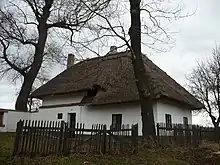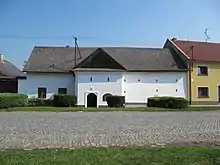Haná
Haná or Hanakia (Czech: Haná or Hanácko, German: Hanna or Hanakei) is an ethnographic region in central Moravia in the Czech Republic.




Description
Its core area is located along the eponymous river of Haná, around the towns of Vyškov and Prostějov, but in common perception it roughly corresponds to the whole Upper Morava Valley, with Olomouc as its natural centre. In terms of the actual administrative division, Haná covers the most of Olomouc Region and adjacent parts of South Moravian Region and Zlín Region.
The so-called Malá Haná ("Lesser Hanakia") is located in the Boskovice Furrow, west of Haná proper.
Haná is known for its agricultural fertility, rich costumes, and traditional customs. The Haná dialect (Hanakian dialect, Czech: hanáčtina) is spoken in the region, and is part of the Central Moravian dialect group (which is even often referred to as the "Hanakian dialects"). This traditional dialect has been preserved and continues to be used even in printed publications from the region. Folk music from Haná is recognized locally by its lyrics in the Haná dialect.
Name
In the 18th and 19th century, the term "Hanack" (Hanák, French: Hanaque),[1] was used for a Slavic people, peasants, in Moravia.[2] Today, the Czech term Hanáci is used for an ethnographic group inhabiting the Haná region.
Significant places
- Olomouc - the centre of Haná and the historical capital of Moravia with a pilgrimage site of Svatý Kopeček
- Přerov - industrial city, well known as an archeologically significant place where mammoth hunters settled in Předmostí.
- Prostějov - nicknamed the "Manchester of Haná" and, prior to the Holocaust, "Jerusalem of Haná".[3]
- Kroměříž - nicknamed the "Athens of Haná".[4]
- Vyškov - formerly called "Moravian Versailles" or "Versailles of Haná".[5]
- Litovel - nicknamed the "Venice of Haná".[6]
- Litovelské pomoraví Protected Landscape Area
- Příkazy - the Haná Open Air Museum
- Kojetín
- Náměšť na Hané
- Hulín
- Holešov
References
- Stanislav Brouček; Richard Jeřábek (2007). Lidová kultura: národopisná encyklopedie Čech, Moravy a Slezska. Mladá fronta. ISBN 978-80-204-1711-4.
Hanaque Paisan qui habite les confins de la Moravie - A Hanack. Or a Peasant inhabiting y Con- fines of Moravia
- Conrad Malte-Brun; Jean-Jacques-Nicolas Huot (1834). A system of universal geography: or A description of all the parts of the world, on a new plan, according to the great natural divisions of the globe. S. Walker. pp. 726–.
the different Slavonic tribes, may still be distinguished, not only in Bohemia, but in Moravia and Silesia, although many German words have been introduced into them. . The Hannack is harsh in its pronunciation ; the Slowack is divided into two sub-dialects, the Moravian Slowack, which is spoken by the Slowacks and the ...
- "Holocaust v Prostějově". Archived from the original on 4 November 2012. Retrieved 1 November 2012.
- "Welcoming Kromeriz boasts a UNESCO sight". Archived from the original on 28 May 2012. Retrieved 1 November 2012.
- "Vyškov". Retrieved 1 November 2012.
- "Hanácké Benátky 2012". Retrieved 1 November 2012.
External links
- Central Moravia Archived 2017-06-13 at the Wayback Machine
- Folklore from Haná (in Czech)
- Folklore group Hanačka
- About the Haná dialect (in Czech)